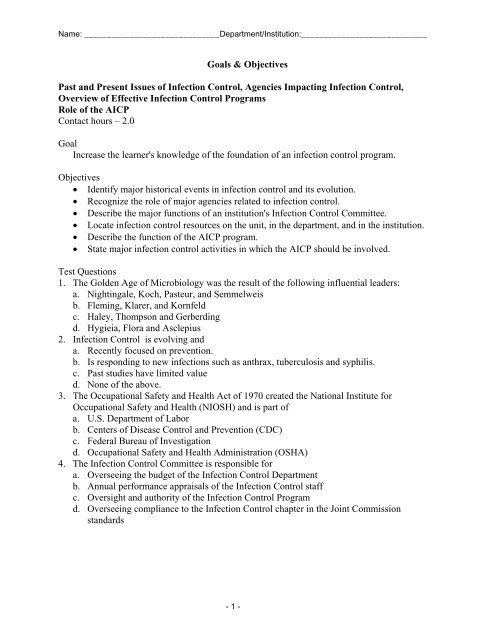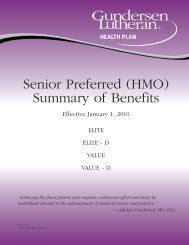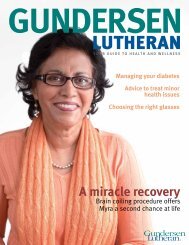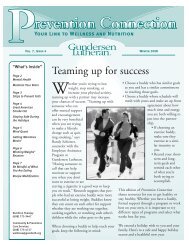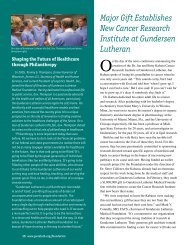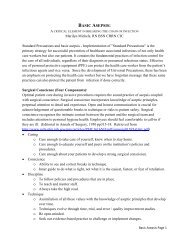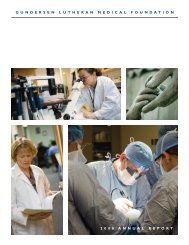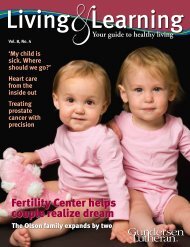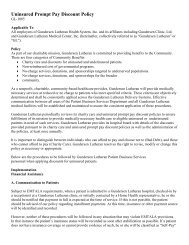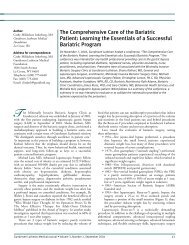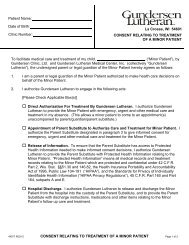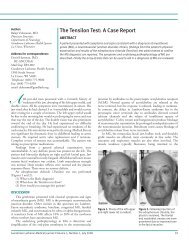Goals & Objectives Past and Present Issues of Infection Control ...
Goals & Objectives Past and Present Issues of Infection Control ...
Goals & Objectives Past and Present Issues of Infection Control ...
You also want an ePaper? Increase the reach of your titles
YUMPU automatically turns print PDFs into web optimized ePapers that Google loves.
Name: ______________________________Department/Institution:____________________________<br />
<strong>Goals</strong> & <strong>Objectives</strong><br />
<strong>Past</strong> <strong>and</strong> <strong>Present</strong> <strong>Issues</strong> <strong>of</strong> <strong>Infection</strong> <strong>Control</strong>, Agencies Impacting <strong>Infection</strong> <strong>Control</strong>,<br />
Overview <strong>of</strong> Effective <strong>Infection</strong> <strong>Control</strong> Programs<br />
Role <strong>of</strong> the AICP<br />
Contact hours – 2.0<br />
Goal<br />
Increase the learner's knowledge <strong>of</strong> the foundation <strong>of</strong> an infection control program.<br />
<strong>Objectives</strong><br />
• Identify major historical events in infection control <strong>and</strong> its evolution.<br />
• Recognize the role <strong>of</strong> major agencies related to infection control.<br />
• Describe the major functions <strong>of</strong> an institution's <strong>Infection</strong> <strong>Control</strong> Committee.<br />
• Locate infection control resources on the unit, in the department, <strong>and</strong> in the institution.<br />
• Describe the function <strong>of</strong> the AICP program.<br />
• State major infection control activities in which the AICP should be involved.<br />
Test Questions<br />
1. The Golden Age <strong>of</strong> Microbiology was the result <strong>of</strong> the following influential leaders:<br />
a. Nightingale, Koch, <strong>Past</strong>eur, <strong>and</strong> Semmelweis<br />
b. Fleming, Klarer, <strong>and</strong> Kornfeld<br />
c. Haley, Thompson <strong>and</strong> Gerberding<br />
d. Hygieia, Flora <strong>and</strong> Asclepius<br />
2. <strong>Infection</strong> <strong>Control</strong> is evolving <strong>and</strong><br />
a. Recently focused on prevention.<br />
b. Is responding to new infections such as anthrax, tuberculosis <strong>and</strong> syphilis.<br />
c. <strong>Past</strong> studies have limited value<br />
d. None <strong>of</strong> the above.<br />
3. The Occupational Safety <strong>and</strong> Health Act <strong>of</strong> 1970 created the National Institute for<br />
Occupational Safety <strong>and</strong> Health (NIOSH) <strong>and</strong> is part <strong>of</strong><br />
a. U.S. Department <strong>of</strong> Labor<br />
b. Centers <strong>of</strong> Disease <strong>Control</strong> <strong>and</strong> Prevention (CDC)<br />
c. Federal Bureau <strong>of</strong> Investigation<br />
d. Occupational Safety <strong>and</strong> Health Administration (OSHA)<br />
4. The <strong>Infection</strong> <strong>Control</strong> Committee is responsible for<br />
a. Overseeing the budget <strong>of</strong> the <strong>Infection</strong> <strong>Control</strong> Department<br />
b. Annual performance appraisals <strong>of</strong> the <strong>Infection</strong> <strong>Control</strong> staff<br />
c. Oversight <strong>and</strong> authority <strong>of</strong> the <strong>Infection</strong> <strong>Control</strong> Program<br />
d. Overseeing compliance to the <strong>Infection</strong> <strong>Control</strong> chapter in the Joint Commission<br />
st<strong>and</strong>ards<br />
- 1 -
Name: ______________________________Department/Institution:____________________________<br />
5. <strong>Infection</strong> <strong>Control</strong> resources may include<br />
a. Discussion with peers at a local Association for Pr<strong>of</strong>essionals in <strong>Infection</strong> <strong>Control</strong> <strong>and</strong><br />
Epidemiology (APIC) chapter meeting<br />
b. Review <strong>of</strong> infection control publications from the Centers <strong>of</strong> Disease <strong>Control</strong> <strong>and</strong><br />
Prevention (CDC)<br />
c. Contacting the local health department<br />
d. All <strong>of</strong> the above<br />
6. An Associate <strong>Infection</strong> <strong>Control</strong> Practitioner (AICP) is recognized as:<br />
a. The liaison with Quality Assurance<br />
b. The immunization coordinator within the department<br />
c. A unit based resource for the unit who has a deep underst<strong>and</strong>ing <strong>of</strong> the clinical area they<br />
practice along with infection control practices.<br />
d. The St<strong>and</strong>ard Precautions Assessment observer.<br />
7. The Associate <strong>Infection</strong> <strong>Control</strong> Practitioner (AICP) at Gundersen Lutheran is expected to<br />
participate in<br />
a. The Flu Shot clinic <strong>and</strong> TB skin testing program<br />
b. The AICP education program, AICP work groups <strong>and</strong> St<strong>and</strong>ard Precaution Assessments<br />
c. The Cold Chain Management program<br />
d. The Patient Safety Measures.<br />
- 2 -
Name: ______________________________Department/Institution:____________________________<br />
Support Services<br />
Contact hours – 2.0<br />
<strong>Goals</strong> & <strong>Objectives</strong><br />
Goal<br />
The learner will have a basic underst<strong>and</strong>ing <strong>of</strong> the relationship between several key Support<br />
Services <strong>and</strong> <strong>Infection</strong> <strong>Control</strong>.<br />
<strong>Objectives</strong><br />
Identify key infection control risks as it relates to the following support services:<br />
• Food H<strong>and</strong>ling<br />
• Waste Management<br />
• Laundry<br />
• Pharmacy<br />
• Facility Operations<br />
• H<strong>and</strong>ling Supplies<br />
Identify key infection control interventions as it relates to the above identifies risks in the<br />
following support services:<br />
• Food H<strong>and</strong>ling<br />
• Waste Management<br />
• Laundry<br />
• Pharmacy<br />
• Facility Operations<br />
• H<strong>and</strong>ling Supplies<br />
Test Questions<br />
1. The temperature danger zone for potentially hazardous foods is<br />
a. 36°-46° F<br />
b. 40°-140° F<br />
c. 140°-180° F<br />
d. 26°-32° F<br />
2. Infectious waste is<br />
a. The solid waste generated by a hospital or health care institution.<br />
b. Solid waste that is medical waste.<br />
c. Hazardous waste that is collected by a registered hazardous waste transporter.<br />
d. Solid waste that contains pathogens with significant virulence <strong>and</strong> capable <strong>of</strong><br />
causing disease.<br />
- 3 -
Name: ______________________________Department/Institution:____________________________<br />
3. Dirty linen should be<br />
a. Sorted <strong>and</strong> rinsed at the point <strong>of</strong> generation.<br />
b. H<strong>and</strong>led with the appropriate personal protective equipment (PPE).<br />
c. Collected by throwing loose linen down the laundry chute.<br />
d. Collected in the linen bag stored in the clean utility room.<br />
4. Laminar flow hoods are used to<br />
a. Mix all chemotherapy agents<br />
b. Provide a sterile environment to h<strong>and</strong>le specimens<br />
c. Provide a sterile environment to prepare parental medication<br />
d. Provide a safe environment when preparing hazardous medication.<br />
5. Facility Operations is responsible for providing safe<br />
a. Air<br />
b. Water<br />
c. Drainage<br />
d. All <strong>of</strong> the above<br />
6. Safe h<strong>and</strong>ling <strong>of</strong> supplies includes<br />
a. Humidity levels between 10-30%<br />
b. Temperature levels between 60-85° F<br />
c. Storing items in original brown corrugated packing box to track lot numbers<br />
d. Storing items 8 inches from the floor, 2 inches from the outside wall <strong>and</strong> 18<br />
inches from ceiling fixtures.<br />
- 4 -
Name: ______________________________Department/Institution:____________________________<br />
Sterilization & Disinfection<br />
Contact hours – 2.0<br />
<strong>Goals</strong> & <strong>Objectives</strong><br />
Goal<br />
To increase the learner's basic underst<strong>and</strong>ing <strong>of</strong> the principles used in sterilization, disinfection<br />
<strong>and</strong> sanitation in a health care setting.<br />
<strong>Objectives</strong><br />
• Describe the appropriate uses <strong>of</strong> cleaning, disinfection, <strong>and</strong> sterilization.<br />
• Name two disinfection procedures used at the hospital.<br />
• List two ways the sterilization process is monitored.<br />
• Identify key issues in the safe h<strong>and</strong>ling <strong>of</strong> gluteraldehyde.<br />
• Recall the key aspects in the safe h<strong>and</strong>ling <strong>of</strong> endoscopes.<br />
• Identify key infection control risks with the appropriate interventions as it relates to<br />
instrument h<strong>and</strong>ling.<br />
Test Questions<br />
1. Tissue forceps used to remove foreign objects from an acute trauma wound should be<br />
a. Disinfected before use.<br />
b. Sterilized in a peal pouch in the procedure room.<br />
c. Cleaned, packaged sterilized in an area outside the procedure room.<br />
d. Flash sterilized.<br />
2. High level disinfection is required for items having contact with mucous membrane <strong>and</strong><br />
includes<br />
a. Use <strong>of</strong> a surfactant on a chronic wound<br />
b. <strong>Past</strong>eurization or soaking in gluteraldehyde<br />
c. 10 seconds <strong>of</strong> wet contact time from use <strong>of</strong> an alcohol prep pad.<br />
d. Wiping a surface <strong>of</strong>f with a cleaning rag dampened with a quaternary solution.<br />
3. Sterilizers are monitored by<br />
a. Biological, chemical <strong>and</strong> mechanical indicators<br />
b. The test strip inside the wrapped sterile pack<br />
c. A chemical integrator when the biologic indicator is only done once a week<br />
d. The printout from the sterilizer <strong>of</strong> the time, temperature <strong>and</strong> pressure recording.<br />
4. Gluteraldehyde requires the use <strong>of</strong> the following personal protective equipment<br />
a. Goggles, respirator, <strong>and</strong> gloves<br />
b. Nitrile gloves, <strong>and</strong> respirator<br />
c. Splash pro<strong>of</strong> goggles, nitrile gloves, <strong>and</strong> impermeable gown.<br />
d. ‘C’ above <strong>and</strong> a self contained breathing apparatus (SCBA) if there are unacceptable<br />
vapor levels.<br />
- 5 -
Name: ______________________________Department/Institution:____________________________<br />
5. Flexible endoscopes should be cleaned<br />
a. Before high level disinfection is done.<br />
b. But it is necessary to perform pressure leak testing prior to immersion in an enzyme<br />
solution.<br />
c. By personnel that completed the competency program commensurate with their assigned<br />
duties.<br />
d. All <strong>of</strong> the above.<br />
6. Flash sterilization is done<br />
a. on all implants to ensure just in time sterility<br />
b. when there is a shortage <strong>of</strong> instruments <strong>and</strong> scheduled cases have been confirmed<br />
c. in the Central Service department to improve their turn around time<br />
d. only during emergent situations.<br />
- 6 -
Name: ______________________________Department/Institution:____________________________<br />
Resources for <strong>Infection</strong> <strong>Control</strong> Practitioners<br />
Contact hours – 0.5<br />
<strong>Goals</strong> & <strong>Objectives</strong><br />
Goal<br />
To increase the learner's basic underst<strong>and</strong>ing <strong>of</strong> the commonly used resources in infection<br />
control.<br />
<strong>Objectives</strong><br />
• Name one book that should be readily available to all infection control practitioners.<br />
• Name one journal/report that is available at a low cost.<br />
• List two reputable Internet sites used by infection control practitioners.<br />
Test<br />
1. A reasonably priced reference book that should be available to infection control<br />
pr<strong>of</strong>essionals is<br />
a. The Pink Book from CDC<br />
b. Notes on Nursing by Florence Nightingale<br />
c. The Great Influenza by John Barry<br />
d. <strong>Control</strong> <strong>of</strong> Communicable Diseases Manual by David Heymann<br />
2. A low cost journal/report available at no cost electronically from CDC is<br />
a. The MMWR<br />
b. American Journal <strong>of</strong> <strong>Infection</strong> <strong>Control</strong> (AJIC)<br />
c. <strong>Infection</strong> <strong>Control</strong> <strong>and</strong> Hospital Epidemiology (ICHE)<br />
d. Clinical Infectious Diseases (CID)<br />
3. A reputable website with valuable information for infection control practitioners <strong>and</strong> the<br />
lay person is<br />
a. www.cdc.gov<br />
b. www.gundluth.org<br />
c. www.google.com<br />
d. www.stophospitalinfections.org<br />
- 7 -
Name: ______________________________Department/Institution:____________________________<br />
Basic Asepsis<br />
Contact hours – 1.0<br />
<strong>Goals</strong> & <strong>Objectives</strong><br />
Goal<br />
To increase the learner's basic underst<strong>and</strong>ing <strong>of</strong> the basic principles necessary for asepsis in the<br />
health care setting.<br />
<strong>Objectives</strong><br />
• List the four components <strong>of</strong> surgical conscience.<br />
• Differentiate between clean technique <strong>and</strong> sterile technique.<br />
• Identify the precautions required for a minor invasive procedure.<br />
Test Questions<br />
1. The four components <strong>of</strong> surgical conscience are:<br />
a. Trust, faith, reciprocity, <strong>and</strong> equity.<br />
b. Calmness, wisdom, cleanliness <strong>and</strong> duty.<br />
c. Caring, conscience, discipline <strong>and</strong> technique.<br />
d. <strong>Control</strong>, practice, speed <strong>and</strong> health.<br />
2. Clean technique or medical asepsis is appropriate for<br />
a. Sterile cavity procedures<br />
b. Chronic wounds requiring extensive debridement <strong>and</strong> reconstruction<br />
c. Chronic wounds<br />
d. Vaginal delivery<br />
3. Asepsis used during a minor invasive procedure<br />
a. Builds upon St<strong>and</strong>ard Precautions <strong>and</strong> aseptic use <strong>of</strong> personal protective<br />
equipment (PPE).<br />
b. Requires use <strong>of</strong> sterile gloves<br />
c. Requires freshly applied nail extenders<br />
d. A&B above.<br />
- 8 -
Name: ______________________________Department/Institution:____________________________<br />
Microbiology Basics<br />
Contact hours – 2.0<br />
<strong>Goals</strong> & <strong>Objectives</strong><br />
Goal<br />
Improve the learner's underst<strong>and</strong>ing <strong>of</strong> elementary microbiology as it relates to infection control.<br />
<strong>Objectives</strong><br />
• Recall the common functions or roles that the Microbiology lab has in infection control.<br />
• Identify the normal flora in the mouth, upper respiratory tract, intestines, external genitalia,<br />
vagina, skin, ears, <strong>and</strong> eyes.<br />
• List organisms that are usually pathogenic when isolated from a patient.<br />
• Identify organisms that are opportunistic infectious agents when isolated from<br />
immunocompromised patients.<br />
• State the importance <strong>of</strong> properly collecting <strong>and</strong> transporting specimens for culture used for<br />
making a clinical diagnosis.<br />
• Describe the procedures for obtaining <strong>and</strong> transporting routine specimens.<br />
• Interpret common microbiological reports.<br />
Test<br />
1. The Microbiology lab has the following roles in infection control:<br />
a. Conducting environmental culturing <strong>of</strong> commonly touched surfaces in the<br />
patient’s environment.<br />
b. Timely identification <strong>and</strong> reporting <strong>of</strong> clinically significant results.<br />
c. Design an effective <strong>Infection</strong> <strong>Control</strong> program based on current state statutes.<br />
d. Order isolation <strong>of</strong> patients based on most recent lab findings.<br />
2. Propionibacterium is considered a commensal organism <strong>of</strong> the:<br />
a. Respiratory tract<br />
b. Gastrointestinal tract<br />
c. Genital urinary tract<br />
d. All <strong>of</strong> the above in addition to the eyes <strong>and</strong> ears.<br />
3. Although Staphylcoccus aureus is commonly carried by about 1/3 <strong>of</strong> the general<br />
population, the presence <strong>of</strong> this organism in one <strong>of</strong> the body sites below is considered<br />
pathogenic.<br />
a. Anterior nares<br />
b. Skin folds<br />
c. Cerebral spinal fluid<br />
d. Perineum<br />
4. The best example <strong>of</strong> an opportunistic infection in an AIDS patient is<br />
a. Yersinia pestis following a trip to New Mexico.<br />
b. Bacillus anthracis from the axilla wound culture after having contact with a<br />
sweater from the Middle East.<br />
c. Pneumocystis pneumonia after not complying with TMP-SMX prophylaxis.<br />
d. Norovirus gastroenteritis following a visit to the local elementary school.<br />
- 9 -
Name: ______________________________Department/Institution:____________________________<br />
5. Which <strong>of</strong> the following is an example <strong>of</strong> a poorly collected specimen?<br />
a. A blood culture report with a coag neg Staph from 1 <strong>of</strong> the 4 bottles.<br />
b. MRSA from an anterior nares culture<br />
c. Neisseria menigiditis from cerebral spinal fluid.<br />
d. E. coli, Enterobacter <strong>and</strong> Enterococcus from an incontinent patient with a recently<br />
inserted indwelling catheter.<br />
6. Which <strong>of</strong> the following is an example <strong>of</strong> an appropriately collected specimen?<br />
a. Collect expectorated sputum from deep in the lungs early in the morning after<br />
patient has rinsed mouth <strong>and</strong> gargled thoroughly with fresh water.<br />
b. Collect a urine specimen from an elderly obese female by using a sterile bedpan<br />
<strong>and</strong> a sterile specimen cup.<br />
c. Collect the pus from a pressure wound after removing the dirty dressing by using<br />
a sterile rayon swab <strong>and</strong> sterile gloves.<br />
d. Collect the last few drops <strong>of</strong> urine into a sterile specimen cup for a Chlamydia<br />
culture.<br />
7. All specimens containing body fluids should be transported to lab<br />
a. Refrigerator to prevent overgrowth <strong>of</strong> bacteria.<br />
b. In a container with a biohazard label.<br />
c. And stored at room temperature for an accurate measure <strong>of</strong> bacteria present.<br />
d. In an anaerobic culturette or similar container.<br />
8. Which <strong>of</strong> the following lab result will probably require treatment by the medical team?<br />
a. Intravascular catheter tip - No growth at 24 hours.<br />
b. Sputum culture – few normal respiratory flora<br />
c. Midstream urine specimen - 1,000 cfu/ml<br />
- 10 -
Name: ______________________________Department/Institution:____________________________<br />
Environmental <strong>Infection</strong> <strong>Control</strong><br />
Contact hours – 1.0<br />
<strong>Goals</strong> & <strong>Objectives</strong><br />
Goal<br />
Appreciate the impact the facility’s environment has upon infection control.<br />
<strong>Objectives</strong><br />
• Identify the role <strong>of</strong> <strong>Infection</strong> <strong>Control</strong> in mitigating patient risks related to indoor air<br />
quality during construction <strong>and</strong> renovation projects.<br />
• Identify the role <strong>of</strong> <strong>Infection</strong> <strong>Control</strong> in mitigating patient risks related to water damage<br />
in the health care setting.<br />
Test<br />
1. Aspergillosis may occur in an immunocompromised host with which renovation project<br />
below.<br />
a. Demolition behind intact barriers <strong>and</strong> negative pressure with air being vented<br />
directly to the outside 50 feet from an air intake.<br />
b. Plumbing project one floor below <strong>and</strong> on a different HVAC system to remove<br />
dead legs.<br />
c. Removal <strong>of</strong> the hallway carpeting in a patient care area to revert back to tazzo<br />
flooring.<br />
d. Demolition <strong>of</strong> the east wing <strong>of</strong> building used to store old equipment on a wet<br />
drizzly day with winds from the west.<br />
2. During one <strong>of</strong> your most recent renovation projects there was a back up <strong>of</strong> gray water<br />
from a floor drain in the basement. An appropriate response by the infection control<br />
practitioner would be to:<br />
a. Assume the role as a Safety Officer during the incident <strong>and</strong> direct staff to avoid<br />
walking through the murky water without protection on their feet <strong>and</strong><br />
appropriately identify the location for barricades.<br />
b. Direct the clean up team to collect all damaged permanent paper records <strong>and</strong><br />
loosely st<strong>and</strong> them up in a crate to facilitate run <strong>of</strong>f <strong>and</strong> aeration while in storage<br />
in a deep freeze.<br />
c. Instruct staff to use alcohol gel during the water use restriction <strong>and</strong> divert<br />
procedures to an area where water restrictions are not in place.<br />
d. All <strong>of</strong> the above.<br />
- 11 -
Name: ______________________________Department/Institution:____________________________<br />
Common Healthcare Associated <strong>Infection</strong>s<br />
Contact hours – 0.75<br />
<strong>Goals</strong> & <strong>Objectives</strong><br />
Goal<br />
To increase the learner's basic knowledge <strong>of</strong> the cause, prevention <strong>and</strong> control <strong>of</strong> health care<br />
associated infections.<br />
<strong>Objectives</strong><br />
• Differentiate between the terms ‘nosocomial infection’ <strong>and</strong> ‘healthcare associated infection’<br />
(HAI).<br />
• Describe each <strong>of</strong> the following common heath care associated infections <strong>and</strong> related infection<br />
control measures.<br />
o Surgical wound infections (SSI)<br />
• wound classification<br />
• ASA score<br />
• cut point T<br />
• risk index<br />
o Pneumonia (refer infection control measures to that specific section)<br />
o Bacteremia (refer infection control measures to that specific section)<br />
o Urinary tract infections<br />
o Oral cavity infections<br />
• Identify the three most common nosocomial infections.<br />
• List common normal body defenses which when impaired may predispose a patient to<br />
development <strong>of</strong> a nosocomial infection.<br />
• Name the common procedures that can compromise a patient's normal defense against<br />
infection.<br />
• Locate the CDC guidelines for the prevention <strong>of</strong> nosocomial infections.<br />
Test<br />
1. While nosocomial infections<br />
a. Primarily focus on infections that are recognized by the healthcare team from the<br />
time <strong>of</strong> admission to discharge; they could also include nosohusial infections.<br />
b. Is a dated term referring to hospital associated infections, the more popular term<br />
today is ‘health care associated infections’ which refers to infections that occur<br />
during the course <strong>of</strong> receiving care in today’s multifaceted health care systems.<br />
c. Typically do not include common community acquired infections such as<br />
measles, it is important to include this information in your annual report to the<br />
medical director <strong>of</strong> the surgery department.<br />
d. Are restricted to infections that are evident 48 hours or more after admission,<br />
healthcare associated infection include infections that have shorter incubation<br />
periods.<br />
- 12 -
Name: ______________________________Department/Institution:____________________________<br />
2. A scheduled laminectomy done on a healthy 34 year old female, mother <strong>of</strong> two young<br />
children <strong>and</strong> is currently breast feeding which took the surgeon 55 minutes to complete<br />
would be most likely be considered a<br />
a. Wound Class I <strong>and</strong> ASA Score 1<br />
b. Wound Class I <strong>and</strong> a Cutpoint T <strong>of</strong> 2.<br />
c. ASA Score <strong>of</strong> 2 <strong>and</strong> Cutpoint T <strong>of</strong> 2<br />
d. Risk Index Score <strong>of</strong> 2.<br />
3. An example <strong>of</strong> a health care associated pneumonia using the CDC definitions is<br />
a. A health care worker seen in the employee health clinic during the influenza<br />
season with rapid onset fever, cough <strong>and</strong> body aches.<br />
b. A patient with a long st<strong>and</strong>ing history <strong>of</strong> COPD with a change in sputum<br />
characteristics to thick green tinges sputum with a sweet smell.<br />
c. A patient admitted for a scheduled coronary artery bypass procedure that<br />
developed persistent left lower lobe infiltrates, fever, cough, rales, increased<br />
production <strong>of</strong> thick creamy sputum <strong>and</strong> required prolonged oxygen therapy.<br />
d. A trauma patient admitted with multiple fractures, including the hip, who<br />
developed acute respiratory distress syndrome three days after admission.<br />
4. A laboratory confirmed blood stream infection<br />
a. Includes all positive blood cultures.<br />
b. Includes positive vascular culture tip cultures obtained from the roll plate method<br />
c. Is a positive blood culture <strong>and</strong> the pathogen isolated is not related to an infection<br />
at another site<br />
d. Is a term limited to patients with a central line in the intensive care unit.<br />
5. A health care associated urinary tract infection<br />
a. Is the most common infection according to CDC reports.<br />
b. Includes patients with a positive urinary antigen for legionella or Streptococcus<br />
pneumoniae following catheterization.<br />
c. Typically occurs following catheterization, a break in the first line <strong>of</strong> defense.<br />
d. A & C above.<br />
6. The CDC guidelines for the prevention <strong>of</strong> health care associated infections<br />
a. Is one document located at http://www.cdc.gov/ncidod/dhqp/guidelines.html<br />
b. Includes the documents for the prevention <strong>of</strong> surgical site infections, h<strong>and</strong><br />
hygiene in health care settings <strong>and</strong> the guideline for isolation precautions.<br />
c. Are restricted to guidelines related to invasive procedures preformed in U.S.<br />
hospitals.<br />
d. Are updated annually by HICPAC.<br />
- 13 -
Name: ______________________________Department/Institution:____________________________<br />
Becoming An Effective Change Agent<br />
Contact hours – 1.0<br />
<strong>Goals</strong> & <strong>Objectives</strong><br />
Goal<br />
To develop a deeper underst<strong>and</strong>ing <strong>of</strong> facilitating change to occur against all forces to resist<br />
change.<br />
<strong>Objectives</strong><br />
• Become aware <strong>of</strong> the expected transitions you <strong>and</strong> others will experience.<br />
• Discover what you will need to be successful in initiating change.<br />
Test<br />
1. During a transition to send all dirty instruments to a central reprocessing area in the<br />
institution, the <strong>Infection</strong> <strong>Control</strong> Pr<strong>of</strong>essional (ICP) can expect all <strong>of</strong> the following<br />
response from the clinic staff except one.<br />
a. ‘CS will never be able to do this <strong>and</strong> the doctors will never tolerate their<br />
instruments leaving their department’<br />
b. ‘I am so happy this change is occurring because now I will be able to spend more<br />
time on patient teaching’<br />
c. ‘They are taking my job away’<br />
d. ‘It will never work.’<br />
2. Managing resistance to the above change by the clinic nursing staff could include<br />
a. Reducing the number <strong>of</strong> nurses in the department <strong>and</strong> hiring more technicians in<br />
Central Service.<br />
b. Purchasing additional bargain instruments to facilitate turn around time.<br />
c. Having a party to celebrate the decision <strong>and</strong> before the conversion is made in case<br />
it does not work out.<br />
d. Identifying key stake holders in each department that can assist in the conversion.<br />
3. Effective change agents in infection control <strong>and</strong> prevention typically<br />
a. Are limited to the chairperson <strong>of</strong> the <strong>Infection</strong> <strong>Control</strong> Committee<br />
b. Are respected by their pears<br />
c. Are in a position <strong>of</strong> authority to force the change to occur<br />
d. Are from the <strong>Infection</strong> <strong>Control</strong> department.<br />
4. Assertive communication is best illustrated by this statement.<br />
a. ‘I think this change will result in an increased turn around time for instrument<br />
processing <strong>and</strong> the need for additional instruments in inventory.’<br />
b. ‘You make me so mad when you change things on me.’<br />
c. ‘Whatever you say.’<br />
d. ‘It is your fault this is not working.’<br />
- 14 -
Name: ______________________________Department/Institution:____________________________<br />
Respiratory System <strong>and</strong> Related Devices<br />
Contact hours – 1.0<br />
<strong>Goals</strong> & <strong>Objectives</strong><br />
<strong>Goals</strong><br />
To familiarize the learner to the prevention <strong>of</strong> infections associated with respiratory care<br />
procedures <strong>and</strong> treatments.<br />
<strong>Objectives</strong><br />
• Identify the population at risk for a respiratory infection.<br />
• Describe alterations <strong>of</strong> the respiratory system that increases the risk <strong>of</strong> infection.<br />
• Describe the procedures/devices associated with risk to infection <strong>and</strong> the interventions to<br />
decrease the risk.<br />
• Locate the CDC's Guidelines for the Prevention <strong>of</strong> Nosocomial Pneumonia.<br />
Test Questions<br />
1. The following groups <strong>of</strong> patients are not at an increased risk for a respiratory infection.<br />
a. Post operative patients, especially following an abdominal procedure.<br />
b. Post operative patients, especially following a LASIK procedure.<br />
c. Patients with a history <strong>of</strong> chronic obstructive pulmonary disease (COPD).<br />
d. The elderly, obese, or those with an impaired cough.<br />
2. Patient actions that may increase the risk for a respiratory infection include<br />
a. Chewing nicotine gum.<br />
b. Gargling with an antimicrobial mouthwash prior to intubation.<br />
c. Getting an annual ‘flu shot’.<br />
d. A recent inhalation injury or trauma.<br />
3. During an infection control walk through, an ICP would take action if the following was<br />
concern was identified.<br />
a. The small volume nebulizer was found sitting on a damp paper towel underneath<br />
the soap dispenser by the h<strong>and</strong>washing sink.<br />
b. The tubing from the ventilator was free from condensate.<br />
c. The bronchoscopy lab had respiratory protection <strong>and</strong> other personal protective<br />
equipment stored in a clean area close to the point <strong>of</strong> use.<br />
d. The in line suction catheter is changed when needed.<br />
4. The Guidelines for Preventing Health-Care-Associated Pneumonia, 2003 are<br />
a. Available at www.cdc.gov<br />
b. Limited to preventing ventilator associated pneumonia (VAP).<br />
c. Outdated<br />
d. Focused on preventing post-op pneumonia.<br />
- 15 -
Name: ______________________________Department/Institution:____________________________<br />
Intravascular – Medication H<strong>and</strong>ling/Devices<br />
Contact hours – 0.75<br />
<strong>Goals</strong> & <strong>Objectives</strong><br />
Goal<br />
To increase the learner's underst<strong>and</strong>ing <strong>of</strong> infection control measures used to prevent<br />
intravascular infections.<br />
<strong>Objectives</strong><br />
• Recall commonly used intravascular devices within the institution.<br />
• Recognize common signs <strong>and</strong> symptoms <strong>of</strong> a vascular related infection.<br />
• Identify common sources <strong>of</strong> contamination <strong>and</strong> related pathogens from medication h<strong>and</strong>ling<br />
<strong>and</strong> intravascular devices.<br />
• State strategies used for the prevention <strong>of</strong> intravascular catheter related infections.<br />
Test<br />
1. Some <strong>of</strong> the most common intravascular devices include peripheral catheters, midline<br />
catheters, <strong>and</strong><br />
a. Central lines<br />
b. Intrathecal devices<br />
c. Transdermal patches<br />
d. Peritoneal dialysis.<br />
2. Patients with a vascular related infection will typically have a laboratory confirmed blood<br />
stream infection <strong>and</strong><br />
a. The same organism cultured from their urinary drainage system.<br />
b. Cellulitis in proximity to a recent surgery.<br />
c. A recent history or a current vascular access device.<br />
d. Red streak along a vein.<br />
3. A possible source <strong>of</strong> contamination<br />
a. May actually be a false positive if aseptic technique is not used when collecting<br />
the blood culture or culturing the vascular device.<br />
b. May occur if admixtures are not prepared in a laminar flow hood by competent<br />
staff.<br />
c. May occur if blood has collected under the dressing <strong>and</strong> along the catheter.<br />
d. All <strong>of</strong> the above.<br />
4. Vascular related infections have been associated with<br />
a. The use <strong>of</strong> Chlorahexidine gluconate or an iodine based product with a polymer.<br />
b. A h<strong>and</strong> scrub with an antimicrobial agent.<br />
c. Use <strong>of</strong> maximum barrier precautions.<br />
d. Use <strong>of</strong> a femoral line in a mildly obese patient.<br />
- 16 -
Name: ______________________________Department/Institution:____________________________<br />
Isolation Precautions<br />
Contact hours – 1.0<br />
<strong>Goals</strong> & <strong>Objectives</strong><br />
Goal<br />
The learner will be familiar with the new isolation precaution guidelines from CDC <strong>and</strong> issues<br />
related to the application <strong>of</strong> these guidelines in various health care settings.<br />
<strong>Objectives</strong><br />
• Recognize the importance <strong>of</strong> h<strong>and</strong>washing in st<strong>and</strong>ard precautions/infection control.<br />
• Name the isolation categories in the new CDC isolation guidelines.<br />
• Discuss implications for application in various settings;<br />
o hospital<br />
o nursing home<br />
o clinic<br />
o home care<br />
• Discuss the implications for the use <strong>of</strong> Emperic Precautions in each <strong>of</strong> the above settings.<br />
• Identify resources available for implementation the new guidelines.<br />
Test<br />
1. The cornerstone <strong>of</strong> an effective infection control program in any setting is<br />
a. Consistent implementation <strong>of</strong> transmission based precautions.<br />
b. H<strong>and</strong> hygiene.<br />
c. Immunization <strong>of</strong> health care workers against influenza.<br />
d. Prompt isolation <strong>of</strong> patients with MRSA infections.<br />
2. The recognized isolation categories or transmission based precautions in the CDC<br />
guidelines released in 2007 are<br />
a. AFB Precautions, Strict Precautions <strong>and</strong> Protective Isolation.<br />
b. Universal Precautions, Contact Precautions, Droplet Precautions, Airborne<br />
Precautions.<br />
c. Contact Precautions, Droplet Precautions, Airborne Precautions<br />
d. None <strong>of</strong> the above<br />
3. Although a private room is recommended for Contact Precautions<br />
a. Cohorting <strong>of</strong> patients may be necessary, especially in some long term care<br />
facilities.<br />
b. When the patient has anthrax, it may be appropriate to use respiratory etiquette in<br />
the clinic setting.<br />
c. It is also recommended for patients in all settings when they have MRSA.<br />
d. In the home care setting, it is not necessary for the home care staff to use gowns<br />
<strong>and</strong> gloves.<br />
- 17 -
Name: ______________________________Department/Institution:____________________________<br />
4. Emperic Precautions or most commonly used in the<br />
a. Hospital setting after culture reports have confirmed the diagnosis.<br />
b. Nursing home for known MRSA carriers.<br />
c. Clinic, Urgent Care <strong>and</strong> emergency room settings when the differential diagnosis<br />
includes a communicable disease.<br />
d. All <strong>of</strong> the above.<br />
5. St<strong>and</strong>ard Precaution guidance may be found<br />
a. at http://www.cdc.gov/ncidod/dhqp/gl_isolation.html<br />
b. at http://www.cdc.gov/niosh/topics/bbp/<br />
c. at http://www.cdc.gov/niosh/topics/tb/<br />
d. at http://www.cdc.gov/hiv/<br />
- 18 -
Name: ______________________________Department/Institution:____________________________<br />
<strong>Goals</strong> & <strong>Objectives</strong><br />
Community Acquired <strong>Infection</strong>s - Respiratory<br />
Contact hours – 1.0<br />
Goal<br />
To increase the learner's awareness <strong>of</strong> common community acquired infections <strong>and</strong><br />
epidemiologic factors.<br />
<strong>Objectives</strong><br />
• Recall the classification system <strong>of</strong> communicable diseases.<br />
• Identify the role <strong>of</strong> the institution in surveillance <strong>and</strong> reporting <strong>of</strong> community acquired<br />
infections.<br />
• Recognize common community acquired infections affecting the respiratory system.<br />
Test<br />
1. Examples <strong>of</strong> Class I diseases are<br />
a. Plague, cholera <strong>and</strong> yellow fever<br />
b. Giardia, hepatitis <strong>and</strong> legionella<br />
c. Lyme disease, genital herpes <strong>and</strong> MRSA<br />
d. All <strong>of</strong> the above<br />
2. Examples <strong>of</strong> Class II diseases include<br />
a. Any suspected bioterrorism event<br />
b. HIV infection<br />
c. Mumps, tuberculosis <strong>and</strong> leprosy<br />
d. Colds, staph infections <strong>and</strong> strep infections<br />
3. Whenever a health care facility suspects an outbreak <strong>of</strong> a communicable disease in the<br />
community they serve, they should<br />
a. Contact the local health department or an <strong>of</strong>ficial at the state health department.<br />
b. Contact the incident comm<strong>and</strong>er<br />
c. Contact Emergency Management about a possible bioterrorism threat<br />
d. Contact the local school nurse to close the school during the outbreak.<br />
4. The ICP may work closely with the local health <strong>of</strong>ficials to<br />
a. Improve communication <strong>and</strong> prompt reporting <strong>of</strong> communicable diseases<br />
requiring prompt investigation <strong>and</strong> isolation.<br />
b. Timely report all suspected diseases<br />
c. Track exposure to lead in the homes<br />
d. Compile reports <strong>of</strong> communicable diseases.<br />
5. The following are classified as a respiratory disease<br />
a. Polio, tetanus <strong>and</strong> yersiniosis<br />
b. Extrapulmonary TB, stomach flu <strong>and</strong> norovirus<br />
c. Legionellosis, pneumococcal pneumonia <strong>and</strong> whooping cough<br />
d. Blastomycocis, anaplasmosis <strong>and</strong> babesiosis.<br />
- 19 -
Name: ______________________________Department/Institution:____________________________<br />
Sexually Transmitted <strong>Infection</strong>s<br />
Contact hours – 0.75<br />
<strong>Goals</strong> & <strong>Objectives</strong><br />
Goal<br />
Underst<strong>and</strong> the infection control <strong>and</strong> prevention issues related to sexually transmitted infections.<br />
<strong>Objectives</strong><br />
• Identify reportable sexually transmitted diseases <strong>and</strong> the appropriate forms used in the state<br />
<strong>of</strong> Wisconsin.<br />
• Recognize the clinical manifestation <strong>of</strong> sexually transmitted diseases (STDs).<br />
• State practices used in the community to prevent the spread <strong>of</strong> sexually transmitted<br />
infections.<br />
• Recall the significant statistics related to STD's in the community.<br />
Test<br />
1. Some <strong>of</strong> the reportable sexually transmitted diseases in the state <strong>of</strong> Wisconsin include<br />
a. HIV, syphilis <strong>and</strong> gonorrhea<br />
b. Endometritis, bacterial vaginosis, prostatitis <strong>and</strong> epididymitis<br />
c. Enteritis, conjunctivitis <strong>and</strong> pneumonia in a newborn<br />
d. Cervical cancer, human papilloma virus (HPV) <strong>and</strong> genital herpes.<br />
2. One <strong>of</strong> the first symptoms <strong>of</strong> syphilis may include<br />
a. A chancre, a painless wet ulcer.<br />
b. A painful wet ulcer in the genital area.<br />
c. A faint diffuse rash with flu like symptoms<br />
d. A white creamy/bloody discharge <strong>and</strong> painful urination<br />
3. Chlamydia can cause<br />
a. Pelvic inflammatory disease (PID)<br />
b. No symptoms in women early in the infection process<br />
c. Pre-term birth <strong>and</strong> the possibility <strong>of</strong> pneumonia <strong>and</strong> eye infection <strong>of</strong> the infant<br />
d. All <strong>of</strong> the above<br />
4. Sexually transmitted diseases can be prevented through<br />
a. Oral sex<br />
b. Anal sex<br />
c. Abstinence <strong>and</strong> effective use <strong>of</strong> condoms<br />
d. Prophylaxis with penicillin after sexual contact<br />
5. There has been an increase in HIV infection in<br />
a. Older adults<br />
b. Heterosexual women<br />
c. Young gay men<br />
d. All <strong>of</strong> the above<br />
- 20 -
Name: ______________________________Department/Institution:____________________________<br />
6. There has been an increase in<br />
a. Fluroquinolone resistant gonococcal infections<br />
b. Syphilis cases in men who have sex with men (MSM)<br />
c. Premature births<br />
d. All <strong>of</strong> the above<br />
- 21 -
Name: ______________________________Department/Institution:____________________________<br />
Community Acquired <strong>Infection</strong>s – All Others<br />
Contact hours – 1.0<br />
<strong>Goals</strong> & <strong>Objectives</strong><br />
Goal<br />
To increase the learner's awareness <strong>of</strong> common community acquired infections <strong>and</strong><br />
epidemiologic factors.<br />
<strong>Objectives</strong><br />
• Recognize common community acquired infections affecting the lymph <strong>and</strong> cardiovascular<br />
system.<br />
• Recognize common community acquired infections affecting the skin <strong>and</strong> eyes.<br />
• Recognize common community acquired infections affecting the nervous system.<br />
• Recognize common community acquired infections affecting the gastrointestinal system.<br />
Test<br />
1. An infection that may affect the lymph <strong>and</strong> cardiovascular system includes<br />
a. Chicken pox<br />
b. Measles<br />
c. Plague<br />
d. All <strong>of</strong> the above<br />
2. An infection that may affect the skin <strong>and</strong> eyes includes<br />
a. Measles<br />
b. Influenza A<br />
c. Cryptosporidiosis<br />
d. All <strong>of</strong> the above<br />
3. An infection that may affect the nervous system includes<br />
a. Herpes Simplex<br />
b. Polio<br />
c. West Nile<br />
d. All <strong>of</strong> the above<br />
4. Pathogenic organisms that may affect the gastrointestinal system includes<br />
a. Escherichia coli O157:h7, Campylobacter jejuni <strong>and</strong> Salmonella<br />
b. Norovirus, influenza Type A <strong>and</strong> Norwalk virus<br />
c. Enteroviruses, CJD <strong>and</strong> anthrax<br />
d. All <strong>of</strong> the above<br />
- 22 -
Name: ______________________________Department/Institution:____________________________<br />
H<strong>and</strong> Hygiene<br />
Contact hours – 0.5<br />
<strong>Goals</strong> & <strong>Objectives</strong><br />
Goal<br />
To increase the learner's awareness <strong>of</strong> the complexity <strong>of</strong> teaching the familiar <strong>and</strong> simple act <strong>of</strong><br />
h<strong>and</strong> hygiene.<br />
Objective<br />
• Recall key points from the CDC guidelines on h<strong>and</strong> hygiene.<br />
• Recall my five moments for h<strong>and</strong> hygiene as identified in the World Health Organization<br />
guidelines.<br />
• Demonstrate 3 simple exercises that may be used to illustrate the importance <strong>of</strong> h<strong>and</strong> hygiene<br />
in stopping disease transmission.<br />
Test<br />
1. The CDC guidelines advocate<br />
a. That nail extenders may be worn as long as they are no longer that ¼ inch from<br />
the tip <strong>of</strong> the finger.<br />
b. That personal h<strong>and</strong> lotion be used to prevent dermatitis.<br />
c. That h<strong>and</strong>s be washed with antimicrobial or non-antimicrobial soap <strong>and</strong> water<br />
whenever they are visibly soiled.<br />
d. All <strong>of</strong> the above<br />
2. My five moments <strong>of</strong> h<strong>and</strong> hygiene are<br />
a. Before <strong>and</strong> after blowing my nose, before <strong>and</strong> after eating <strong>and</strong> after going to the<br />
bathroom.<br />
b. After getting the mail, going to the bathroom, after eating, after blowing my nose<br />
<strong>and</strong> after flossing.<br />
c. Before patient contact, before a aseptic task, after body fluid exposure <strong>and</strong> after<br />
contact with patient surroundings.<br />
d. None <strong>of</strong> the above<br />
3. Of the three fun exercises explained in class,<br />
a. Use <strong>of</strong> the fluorescent powder in a wash cloth <strong>and</strong> a black light can demonstrate<br />
the importance <strong>of</strong> appropriate h<strong>and</strong>ling <strong>of</strong> contaminated patient linen or<br />
equipment.<br />
b. Use <strong>of</strong> the fluorescent powder <strong>and</strong> a black light in alcohol gel can demonstrate the<br />
importance <strong>of</strong> have alcohol gel readily available at the bedside for patient use.<br />
c. Use <strong>of</strong> acrylic paint <strong>and</strong> nitrile gloves to demonstrate the importance <strong>of</strong> removing<br />
contaminated gloves immediately after use.<br />
d. None <strong>of</strong> the above.<br />
- 23 -
Name: ______________________________Department/Institution:____________________________<br />
Renal Dialysis<br />
Contact hours – 0.75<br />
<strong>Goals</strong> & <strong>Objectives</strong><br />
Goal<br />
To increase the learner's underst<strong>and</strong>ing <strong>of</strong> infection control strategies for patients with<br />
impaired renal functioning.<br />
<strong>Objectives</strong><br />
• Describe the infection control issues w/ patients with various degrees <strong>of</strong> renal function.<br />
• Describe the infection control issues <strong>and</strong> measures taken with dialysis.<br />
Test<br />
1. The patients with renal failure may require peritoneal dialysis through Continous<br />
Ambulatory Peritoneal Dialysis (CAPD) or Continuous Cycling Peritoneal Dialysis<br />
(CCPD) but<br />
a. Should never go swimming.<br />
b. Should be taught sterile technique to access the catheter.<br />
c. May be allowed dump the dialysate fluid into the shared sink in a semi-private<br />
room.<br />
d. This may place them at an increase risk for chronic glomerulo-nephritis<br />
2. The patients with renal failure may require hemodialysis but<br />
a. This is only done in dialysis centers <strong>and</strong> not in the home setting<br />
b. This increases their risk to acquire a blood stream infection if asepsis is not used<br />
to access the line <strong>and</strong> safe medication h<strong>and</strong>ling practices are consistently used.<br />
c. This increases the risk to the patient to acquire influenza, pneumonia or shingles<br />
due to the ward like setting in the dialysis unit.<br />
d. This increases the risk to health care workers in the dialysis center to hepatitis C.<br />
- 24 -
Name: ______________________________Department/Institution:____________________________<br />
Vaccine Preventable Diseases<br />
Contact hours – 1.25<br />
<strong>Goals</strong> & <strong>Objectives</strong><br />
Goal<br />
To increase learner's appreciation for vaccines <strong>and</strong> the impact they have in promoting public<br />
health.<br />
<strong>Objectives</strong><br />
• Recall the St<strong>and</strong>ards for Pediatric Child <strong>and</strong> Adolescent Immunization Practices & St<strong>and</strong>ards<br />
for Adult Immunization Practices.<br />
• Recall basic principles <strong>of</strong> immunology <strong>and</strong> related terminology.<br />
o passive immunity<br />
o active immunity<br />
• Identify the classification <strong>of</strong> vaccines.<br />
o live attenuated<br />
o inactivated<br />
o conjugate<br />
o recombinant<br />
• Recognize the current recommended immunization schedule for children <strong>and</strong> adults.<br />
• Identify contraindications for receiving vaccines.<br />
• Identify the role <strong>of</strong> the public health department in vaccine preventable diseases.<br />
• Identify the role <strong>of</strong> the health care worker at Gundersen Lutheran in vaccine preventable<br />
diseases <strong>and</strong> preventing missed opportunities to vaccinate.<br />
Test<br />
1. The St<strong>and</strong>ards for Child <strong>and</strong> Adolescent Immunization Practices <strong>and</strong> St<strong>and</strong>ards for Adult<br />
Immunization Practices include which <strong>of</strong> the following premises:<br />
a. Vaccines should be readily available at a minimal cost.<br />
b. Vaccines should be properly stored <strong>and</strong> h<strong>and</strong>led with oversight by a properly<br />
trained health care worker.<br />
c. Immunizations should be administered simultaneously as much as possible but<br />
not mixed together into one syringe<br />
d. All <strong>of</strong> the above.<br />
2. Immunizations provide<br />
a. Passive immunity<br />
b. Active immunity through natural immunity<br />
c. Antigen specific immunity<br />
d. None <strong>of</strong> the above<br />
- 25 -
Name: ______________________________Department/Institution:____________________________<br />
3. Live attenuated vaccines<br />
a. Include measles, mumps, rubella, polio, yellow fever, vaccinia <strong>and</strong> varicella<br />
vaccines.<br />
b. Include pneumococcal, meningococcal <strong>and</strong> H. influenza vaccines.<br />
c. Include the hepatitis B vaccine <strong>and</strong> the HPV vaccine.<br />
d. All <strong>of</strong> the above.<br />
4. A two month old infant coming to the clinic for their first visit may be due for their<br />
a. Hep B, Rota, DTaP, Hib, PCV <strong>and</strong> IPV immunizations<br />
b. Hep B, Hib, PCV, IPV, Influ, MMR, Varicella <strong>and</strong> Hep A immunizations<br />
c. PPV, Influ, Hep A <strong>and</strong> MCV4 immunizations<br />
d. None <strong>of</strong> the above.<br />
5. An appropriate screening question for a pregnant women presenting for a flu shot would<br />
be:<br />
a. Are you allergic to any medications, food or vaccines?<br />
b. Are you currently breastfeeding?<br />
c. Would you like a copy <strong>of</strong> the Vaccine Information Statement after we vaccinate<br />
you?<br />
d. None <strong>of</strong> the above.<br />
- 26 -
Name: ______________________________Department/Institution:____________________________<br />
Employee Health <strong>Issues</strong><br />
Contact hours – 1.0<br />
<strong>Goals</strong> & <strong>Objectives</strong><br />
Goal<br />
To increase learner's appreciation for the inter relatedness between employee health <strong>and</strong><br />
infection control <strong>and</strong> prevention in the health care setting.<br />
<strong>Objectives</strong><br />
• Identify the key elements <strong>of</strong> an effective personnel health services program.<br />
• Name several instances when it would be necessary to be <strong>of</strong>f duty (or without patient<br />
contact) because <strong>of</strong> illness, or an exposure.<br />
• List three diseases for which protection is important for health personnel.<br />
• State the procedure to be followed for a possible exposure to blood/body fluids.<br />
• Recall the major components <strong>of</strong> the Blood-borne Pathogen Exposure <strong>Control</strong> Plan <strong>and</strong><br />
related policies.<br />
• Discuss CDC's guidelines for <strong>of</strong>fering chemoprophylaxis following an exposure to HIV.<br />
Test<br />
1. The employee health program in a health care facility should include<br />
a. A vaccination program against influenza.<br />
b. An education program for new employees on the appropriate use <strong>of</strong> personal<br />
protective equipment, when to call in sick <strong>and</strong> anticipated medical screening<br />
based on risk.<br />
c. A plan to reduce risk to the employee<br />
d. All <strong>of</strong> the above.<br />
2. Employees exposed to<br />
a. Mumps should be <strong>of</strong>f duty for 12-25 days after the exposure.<br />
b. Chicken pox should be <strong>of</strong>f duty from 10-21 days after the exposure.<br />
c. Chicken pox should be <strong>of</strong>f duty from 10-21 days after the exposure if there is no<br />
documented immunity to the disease.<br />
d. Pertussis should take clarithromycin for 5 days regardless <strong>of</strong> symptomology.<br />
3. The employee health program relies on employees to protect themselves from these<br />
diseases through the st<strong>and</strong>ard use <strong>of</strong> personal protective equipment<br />
a. Cold sores <strong>and</strong> the common cold.<br />
b. Varicella, mumps, measles <strong>and</strong> rubella<br />
c. HIV, Hepatitis B <strong>and</strong> Hepatitis C<br />
d. All <strong>of</strong> the above<br />
- 27 -
Name: ______________________________Department/Institution:____________________________<br />
4. The first thing the nurse should do following an possible significant exposure to the<br />
patient’s blood is<br />
a. Suck the blood from the wound or apply a tourniquet above the puncture site.<br />
b. Wash the wound with mild soap <strong>and</strong> water.<br />
c. Report the incident to the employee health nurse regardless <strong>of</strong> the time <strong>of</strong> day.<br />
d. None <strong>of</strong> the above.<br />
5. The Bloodborne Pathogen Exposure <strong>Control</strong> Plan<br />
a. Is available to all employees<br />
b. Includes providing education to all at risk employees on the BBP st<strong>and</strong>ard,<br />
epidemiology <strong>of</strong> BBP, modes <strong>of</strong> transmission, the Exposure <strong>Control</strong> Plan <strong>and</strong> the<br />
Hepatitis B vaccination program.<br />
c. Include recordkeeping protocols for exposure reports <strong>and</strong> follow-up<br />
d. All <strong>of</strong> the above.<br />
6. Chemoprophylaxis following a significant exposure to a patient at a high risk for<br />
Hepatitis C would include<br />
a. Combivir <strong>and</strong> a protease inhibitor<br />
b. Immune globulin<br />
c. Ribavirin<br />
d. None <strong>of</strong> the above<br />
- 28 -
Name: ______________________________Department/Institution:____________________________<br />
Education Principles<br />
Contact hours – 1.25<br />
<strong>Goals</strong> & <strong>Objectives</strong><br />
Goal<br />
To develop an underst<strong>and</strong>ing <strong>of</strong> the teaching <strong>and</strong> learning principles necessary for developing,<br />
implementing <strong>and</strong> evaluating educational programs.<br />
<strong>Objectives</strong><br />
• Describe the principles <strong>of</strong> adult learning.<br />
• Incorporate Maslow’s Hierarchy <strong>of</strong> Needs into adult motivation to learn.<br />
• Apply program planning, implementation, <strong>and</strong> evaluation process to the AICP class.<br />
• Assess learning needs on the units <strong>and</strong> within the nursing department.<br />
Test<br />
1. Adult learning principles include the following assumption<br />
a. The adult learner needs to participate in identifying their learning needs.<br />
b. The adult learner needs to participate in establishing their learning goal.<br />
c. The adult learner prefers a learning environment that is respectful <strong>and</strong><br />
collaborative.<br />
d. All <strong>of</strong> the above.<br />
2. Based on Maslow’s Hierarchy <strong>of</strong> Needs, the adult learner is motivated to learn when<br />
a. Their physiologic needs are met.<br />
b. They feel safe <strong>and</strong> secure.<br />
c. They are viewed by others to be intelligent.<br />
d. None <strong>of</strong> the above.<br />
3. When designing this orientation program for the novice infection control<br />
pr<strong>of</strong>essional/preventionalist<br />
a. It is important to have the learner attend the program planning sessions.<br />
b. It is important to assess the learner’s needs <strong>and</strong> establish the related goals <strong>and</strong><br />
objectives <strong>of</strong> the program.<br />
c. It is important to find entertaining speakers <strong>and</strong> identify the theme <strong>of</strong> the program<br />
for the learner’s enjoyment.<br />
d. It is important for the learner to get 100% on their exam so it is evident the<br />
teacher did an adequate job <strong>of</strong> teaching.<br />
4. Learning needs for a nursing area can best be determined by<br />
a. Monitoring performance <strong>and</strong> determining if poor performance is due an<br />
administrative issue or a learning need.<br />
b. Asking the novice what they want to know about an unfamiliar topic without any<br />
prompting by the instructor to avoid imposing a bias.<br />
c. Removing the motivational factors to reduce stress in the learning environment.<br />
d. None <strong>of</strong> the above.<br />
- 29 -
Name: ______________________________Department/Institution:____________________________<br />
Immunology<br />
Contact hours – 1.25<br />
<strong>Goals</strong> & <strong>Objectives</strong><br />
<strong>Goals</strong><br />
To improve the learner's underst<strong>and</strong>ing <strong>of</strong> how immunology relates to infection control.<br />
<strong>Objectives</strong><br />
• Briefly describe immunology <strong>and</strong> related terms.<br />
• Briefly describes how the immune system works.<br />
• Interpret common reports from the Immunology lab.<br />
Test<br />
1. Immunology<br />
a. Is the study <strong>of</strong> reactions by a specific group <strong>of</strong> antigens introduced by a nutrient.<br />
b. Is the limited study <strong>of</strong> an inflammatory response following tissue damage.<br />
c. Is the study <strong>of</strong> all aspects <strong>of</strong> the immune system including its structure <strong>and</strong><br />
function, disorders <strong>of</strong> the immune system, blood banking, immunization <strong>and</strong><br />
organ transplantation.<br />
d. All <strong>of</strong> the above<br />
2. An antigen is<br />
a. A familiar cell within the body.<br />
b. Part <strong>of</strong> the humoral acquired immunity.<br />
c. A foreign invader.<br />
d. Part <strong>of</strong> the specific immune system that is derived from the B lymphocytes.<br />
3. The immune system is<br />
a. A complex network <strong>of</strong> specialized cells <strong>and</strong> organs whose primary job is to<br />
protect us from foreign invaders through our innate <strong>and</strong> acquired immunity.<br />
b. Derived from the thymus, bone marrow, spleen, lymph nodes, tonsils, appendix,<br />
Peyer’s patches <strong>and</strong> MALT.<br />
c. Primarily dependent on B lymphocytes <strong>and</strong> T lymphocytes for specific immunity.<br />
d. All <strong>of</strong> the above.<br />
4. T lymphocytes originate from the hematopoietic stem cells but migrate to the thymus<br />
<strong>and</strong><br />
a. Some may eventually evolve into the T helper cell (CD4) which secretes<br />
cytokines when activated<br />
b. Some may eventually evolve into the T cytotoxic cell (CD8) which destroys<br />
virally infected cells.<br />
c. Only the T cells can recognize antigens originating from the cells within the host.<br />
d. All <strong>of</strong> the above.<br />
- 30 -
Name: ______________________________Department/Institution:____________________________<br />
5. A pediatric nurse who was exposed to chickenpox in the past 24 hours admits to having<br />
an uncertain immunity to the disease <strong>and</strong> has a negative IgG. Therefore you assume<br />
a. She was vaccinated <strong>and</strong> has waning immunity.<br />
b. She had disease <strong>and</strong> no further action is needed.<br />
c. She did not have disease <strong>and</strong> should be vaccinated plus furloughed 10-21 days<br />
after the exposure.<br />
d. She did not have disease <strong>and</strong> be allowed to work if her coworkers have<br />
documented immunity to the disease.<br />
6. A 40 yr male who was camping last weekend <strong>and</strong> is now presenting with erythema<br />
migrans measuring 4.5 cm in diameter <strong>and</strong> his Lyme disease EIA is 0.34, therefore you<br />
assume<br />
a. He has lyme disease <strong>and</strong> report it to the health department<br />
b. He will need further testing at a later date if this is to meet the case definition for<br />
Lyme Disease for reporting<br />
c. He had a previous exposure <strong>and</strong> has immunity<br />
d. He does not have Lyme disease <strong>and</strong> no further testing is needed.<br />
- 31 -
Name: ______________________________Department/Institution:____________________________<br />
Surveillance & Epidemiology<br />
Contact hours – 2.0<br />
<strong>Goals</strong> & <strong>Objectives</strong><br />
Goal<br />
To provide the learner with the basic knowledge <strong>of</strong> epidemiological principles <strong>and</strong> statistical<br />
methods relevant to infection control.<br />
<strong>Objectives</strong><br />
• Identify the key components <strong>of</strong> epidemiology.<br />
• Describe the links in the chain <strong>of</strong> infection <strong>and</strong> corresponding methods to break the chain.<br />
• Identify the key components to surveillance.<br />
• <strong>Present</strong> data evaluated by statistical measures in an effective manner.<br />
• Demonstrate key components used to conduct an epidemiological study.<br />
Test<br />
1. The Epidemiologic Triangle<br />
a. Considers the strength, consistency, specificity, biologic gradient <strong>and</strong> time<br />
relationship <strong>of</strong> disease causation.<br />
b. Recognizes that only one organism is found with a disease.<br />
c. Consists <strong>of</strong> the host, agent <strong>and</strong> environment.<br />
d. Illustrates the spectrum <strong>of</strong> colonization to infection from an infectious agent.<br />
2. An effective means to break the chain <strong>of</strong> infection is<br />
a. H<strong>and</strong>washing<br />
b. Effective disinfection<br />
c. Education<br />
d. All <strong>of</strong> the above<br />
3. Surveillance requires<br />
a. A consistent method to collect data.<br />
b. Consolidation <strong>of</strong> data<br />
c. Dissemination <strong>of</strong> data<br />
d. All <strong>of</strong> the above<br />
4. When constructing a table or graph, it is important to<br />
a. Have a title that reflects the subject, person, time <strong>and</strong> place.<br />
b. Have color copying.<br />
c. Include all the data in the table<br />
d. Use a pie chart when illustrating the frequency over time.<br />
5. One the most essential steps in an outbreak investigation is to<br />
a. Inform the authorities <strong>of</strong> the outbreak to demonstrate transparency to the<br />
consumer.<br />
b. Order additional lab work <strong>of</strong> the close contacts to confirm your hypothesis<br />
c. Confirm the existence <strong>of</strong> the outbreak with consistent criteria <strong>of</strong> the condition<br />
d. Institute controls immediately to prevent the spread <strong>of</strong> disease.<br />
- 32 -
Name: ______________________________Department/Institution:____________________________<br />
Specialty Areas<br />
Contact hours – 1.75<br />
<strong>Goals</strong> & <strong>Objectives</strong><br />
Goal<br />
To increase the learner's underst<strong>and</strong>ing <strong>of</strong> infection control strategies for special care units.<br />
<strong>Objectives</strong><br />
Describe infection issues in the:<br />
• Ambulatory care setting.<br />
• Home care setting.<br />
• Day Care setting<br />
• Maternity care setting<br />
Test<br />
1. One <strong>of</strong> greatest infection control threats in the ambulatory setting is seeing a large<br />
volume <strong>of</strong> patients with undiagnosed conditions, therefore infection control needs to<br />
focus<br />
a. On h<strong>and</strong> hygiene<br />
b. Environmental cleanliness<br />
c. Respiratory etiquette<br />
d. All <strong>of</strong> the above<br />
2. The infection control risks when providing patient care in the patient’s home include<br />
a. Daily cleaning <strong>of</strong> all surfaces with a mild bleach solution<br />
b. Personal toiletries left by the only h<strong>and</strong>washing sink<br />
c. The family dog that is restricted to farm yard <strong>and</strong> buildings<br />
d. Dressings stored in a clean cabinet located in the patient’s bedroom.<br />
3. Vertical transmission <strong>of</strong> infection from the mom to the infant may occur with the<br />
following organisms during passage through the birth canal:<br />
a. Herpes, GBS <strong>and</strong> MRSA<br />
b. Tuberculosis, chicken pox <strong>and</strong> rubella<br />
c. Lyme disease <strong>and</strong> anaplasmosis<br />
d. None <strong>of</strong> the above.<br />
4. One <strong>of</strong> the greatest infection control risks in the day care setting is<br />
a. Young toddlers sharing the same space during toilet training<br />
b. Having parents not disclose child illness to prevent exclusion from day care.<br />
c. Having the same attendant be responsible for diaper changing <strong>and</strong> feeding.<br />
d. All <strong>of</strong> the above.<br />
- 33 -
Name: ______________________________Department/Institution:____________________________<br />
<strong>Infection</strong>s in the Elderly & Long Term Care<br />
Contact hours – 1.0<br />
<strong>Goals</strong> & <strong>Objectives</strong><br />
Goal<br />
To familiarize the learner to the infection control issues in the long term care setting <strong>and</strong> the<br />
uniqueness <strong>of</strong> the geriatric resident.<br />
<strong>Objectives</strong><br />
• Identify risks to geriatric residents in developing health care associated infections in a<br />
communal setting.<br />
• Identify infection measures used to prevent common health care associated infections in a<br />
long term care facility (LTCF).<br />
Test<br />
1. The two most common health care associated infection <strong>of</strong> geriatric residents in the long<br />
term care facility LTCF are:<br />
a. Surgical site infection <strong>and</strong> urinary tract infections.<br />
b. Gastroenteritis <strong>and</strong> urinary tract infections.<br />
c. Respiratory tract infections <strong>and</strong> urinary tract infections.<br />
d. None <strong>of</strong> the above.<br />
2. The recognition <strong>of</strong> infection in the geriatric population is<br />
a. Relatively easy because the nurse sees the patient every day.<br />
b. Difficult because diagnostic tests <strong>and</strong> equipment are not readily available <strong>and</strong><br />
arrangements must be made to transport the resident to the local hospital.<br />
c. Challenging because the geriatric resident tends to have comorbid conditions that<br />
complicate the presentation <strong>of</strong> an infectious disease.<br />
d. No different than other healthy adults.<br />
3. Prompt treatment with an antibiotic to a suspected infection<br />
a. May be life preserving.<br />
b. Is necessary due to the CMS requirements.<br />
c. May contribute to over use <strong>of</strong> antibiotics <strong>and</strong> subsequent resistant organisms.<br />
d. Is preferred to the ‘wait <strong>and</strong> see’ approach since the geriatric patient is so frail.<br />
4. An effective immunization program to prevent the spread <strong>of</strong> communicable disease in the<br />
long term care facility includes:<br />
a. Vaccinating the residents against influenza, pneumococcal <strong>and</strong> shingles.<br />
b. Vaccinating the staff in the LTCF against influenza at no charge.<br />
c. Having a st<strong>and</strong>ing order in place for amantadine.<br />
d. Placing the TB skin test before vaccinating against influenza.<br />
- 34 -
Name: ______________________________Department/Institution:____________________________<br />
5. During a recognized outbreak in an area <strong>of</strong> the long term care facility, an infection<br />
control measure may include<br />
a. Secluding sick residents.<br />
b. Informing the Medical Director <strong>and</strong> the local health <strong>of</strong>ficial <strong>of</strong> the concern.<br />
c. Review cleaning <strong>and</strong> sanitation practices with Environmental Services.<br />
d. All <strong>of</strong> the above.<br />
- 35 -
Name: ______________________________Department/Institution:____________________________<br />
Resistant Organisms<br />
Contact hours – 0.75<br />
<strong>Goals</strong> & <strong>Objectives</strong><br />
Goal<br />
To increase the learner's underst<strong>and</strong>ing <strong>of</strong> infection control strategies appropriate for h<strong>and</strong>ling<br />
patients with resistant organisms.<br />
<strong>Objectives</strong><br />
• Recall the 12 steps to prevent multiple resistant organisms.<br />
Test<br />
1. The most effective means to prevent infections from developing includes<br />
a. Prompt treatment with antibiotics when there is a positive urine culture.<br />
b. Aggressive use <strong>of</strong> antibiotics with the index case to prevent the spread <strong>of</strong> disease<br />
to other close contacts.<br />
c. Routine use <strong>of</strong> vancomycin to treat patients for a C. difficile infection.<br />
d. H<strong>and</strong> hygiene<br />
2. Vaccination programs are important in<br />
a. The prevention <strong>of</strong> resistant organisms in the hospital setting.<br />
b. The reduction <strong>of</strong> respiratory infections <strong>and</strong> subsequent treatment <strong>of</strong> secondary<br />
bacterial pneumonia.<br />
c. Employee health programs in all health care settings.<br />
d. All <strong>of</strong> the above.<br />
3. Catheter care includes<br />
a. Cleansing the meatus twice a day with an antiseptic solution.<br />
b. Using the smallest catheter possible to prevent local irritation.<br />
c. Using antibiotics when a patient has a WBCs (>10/hpf) in the urine analysis.<br />
d. Promptly returning the urine bucket to the dirty utility room for measuring the<br />
urine output.<br />
4. Antibiograms may provide guidance to physicians on<br />
a. The resistance patterns <strong>of</strong> commonly seen organisms <strong>and</strong> the related formulary.<br />
b. Treatment without culturing the patient <strong>and</strong> therefore saving money <strong>and</strong> possible<br />
pain from specimen collection.<br />
c. Treatment instead <strong>of</strong> ordering a susceptibility panel.<br />
d. The recommended treatment when the culture reports are negative.<br />
- 36 -
Name: ______________________________Department/Institution:____________________________<br />
Wrap Up & Questions<br />
Contact hours – 0.5<br />
<strong>Goals</strong> & <strong>Objectives</strong><br />
Goal<br />
To allow time for the learner to critique this educational program.<br />
Objective<br />
Apply the principles learned in the session, ‘Education Principles’ to the critical evaluation <strong>of</strong><br />
this educational program to improve the content for subsequent programs.<br />
Test<br />
Provide feedback to directly to Marilyn Michels RN MSN CIC (mamichel@gundluth.org) or<br />
Bridget Pfaff MS CIC (blpfaff@gundltuh.org) either by email or telephone (608-775-6810).<br />
- 37 -
Name: ______________________________Department/Institution:____________________________<br />
<strong>Goals</strong> & <strong>Objectives</strong><br />
MRSA<br />
Contact hours – 1.0<br />
Goal<br />
To familiarize the learner to issues related to methicillin resistant Staphylococcal aureus<br />
(MRSA).<br />
<strong>Objectives</strong><br />
Discuss the impact <strong>of</strong> methicillin resistant Staphylococcal aureus (MRSA) in today’s health care<br />
system.<br />
Test<br />
1. Methicillin resistant Staphylococcal aureus (MRSA)<br />
a. Commonly causes superficial skin infections if it is the community associated<br />
strain, but can still cause serious illness.<br />
b. <strong>Infection</strong> rates have dramatically increased in the past 10 years.<br />
c. Requires use <strong>of</strong> more expensive <strong>and</strong> poorly tolerated antibiotics.<br />
d. All <strong>of</strong> the above.<br />
2. The increased presence <strong>of</strong> MRSA<br />
a. May be due to decreased antibiotic use or not finishing prescribed antibiotics,<br />
even if the patient improved a few days after the initiation <strong>of</strong> treatment.<br />
b. May be due to environmental contamination therefore environmental culturing<br />
should be routinely done after room cleaning.<br />
c. Has resulted in increased costs to provide patient care.<br />
d. Has resulted in improved h<strong>and</strong> hygiene compliance rates.<br />
3. MRSA colonization <strong>of</strong> a health care worker (HCW) may result in<br />
a. No change in the risk <strong>of</strong> transmission <strong>of</strong> MRSA to the patient when the HCW<br />
reports to duty with a respiratory illness.<br />
b. A furlough for the health care worker until they have sustained decolonization for<br />
three weeks.<br />
c. Treatment <strong>of</strong> the health care worker’s contact h<strong>and</strong> dermatitis.<br />
d. Immediate termination <strong>of</strong> the health care worker to prevent transmission.<br />
4. MRSA transmission has been associated with<br />
a. Sexual contact.<br />
b. Close contact with a colonized household pet.<br />
c. Close contact with contaminated surfaces.<br />
d. All <strong>of</strong> the above.<br />
- 38 -
Name: ______________________________Department/Institution:____________________________<br />
P<strong>and</strong>emic Preparedness<br />
Contact hours – 1.5<br />
Goal<br />
To familiarize the learner to issues related to p<strong>and</strong>emic influenza preparedness.<br />
<strong>Objectives</strong><br />
Identify common assumptions made for influenza p<strong>and</strong>emic preparedness planning.<br />
Identify the six key components <strong>of</strong> an effective p<strong>and</strong>emic influenza plan.<br />
Test<br />
1. The following assumption related to p<strong>and</strong>emic influenza planning can be made:<br />
a. Some individuals will be impacted <strong>and</strong> this may be contained to Asian countries.<br />
b. There will be adequate resources due to the p<strong>and</strong>emic preparedness activity by<br />
CDC <strong>and</strong> the local health departments.<br />
c. Health care workers will not be at increased risk because there will be adequate<br />
antivirals <strong>and</strong> personal protective equipment.<br />
d. It is inevitable.<br />
2. An effective p<strong>and</strong>emic influenza plan includes a section on<br />
a. Surveillance <strong>of</strong> patients presenting with influenza like illness during times <strong>of</strong><br />
seasonal influenza.<br />
b. Documentation systems used to track immunizations <strong>and</strong> antivirals.<br />
c. Inventory control systems for immunizations <strong>and</strong> antivirals.<br />
d. All <strong>of</strong> the above.<br />
3. In order to be National Incident Management System (NIMS) compliant, the p<strong>and</strong>emic<br />
plan should include incorporation <strong>of</strong><br />
a. Clinical practice issues.<br />
b. The Incident comm<strong>and</strong> system.<br />
c. Patient billing issues.<br />
d. St<strong>and</strong>ard Precautions.<br />
4. Communication will<br />
a. Not be threatened because a p<strong>and</strong>emic does not impact technology.<br />
b. Occur through the local county health department.<br />
c. Rely on pre fabricated messages.<br />
d. Occur through the Public Information Officer.<br />
5. Vaccination against a novel viral threat may<br />
a. Not be available at the beginning <strong>of</strong> the outbreak or p<strong>and</strong>emic.<br />
b. Require investigational drug protocols<br />
c. Be m<strong>and</strong>atory for health care workers<br />
d. All <strong>of</strong> the above.<br />
6. Antiviral/s<br />
a. Should be purchased by patients <strong>and</strong> stored in their home to protect themselves<br />
<strong>and</strong> loved ones.<br />
b. Use may or may not be <strong>of</strong> benefit <strong>and</strong> is dependent upon the resistance <strong>of</strong> the<br />
virus to treatment.<br />
c. Use may be limited to those who can afford treatment.<br />
- 39 -
Name: ______________________________Department/Institution:____________________________<br />
d. Use may replace the need for personal protective equipment by the health care<br />
worker.<br />
7. Health care workers caring for patients with a novel influenza infection<br />
a. Should receive adequate training about the disease to safely care for the patient.<br />
b. Should be familiar with the personal protective equipment needed to safely care<br />
for the patient.<br />
c. Should monitor their health <strong>and</strong> report any symptoms <strong>of</strong> illness to the employee<br />
health representative with a subsequent report to the Safety Officer.<br />
d. All <strong>of</strong> the above.<br />
- 40 -
Name: ______________________________Department/Institution:____________________________<br />
The Role <strong>of</strong> Clinics during a Disaster<br />
Contact hours – 0.75<br />
<strong>Goals</strong> & <strong>Objectives</strong><br />
Goal<br />
To familiarize the learner to issues impacting physician <strong>of</strong>fices during a suspected or confirmed<br />
biologic mass casualty event.<br />
<strong>Objectives</strong><br />
• State the Three Clinical Thresholds used by the state <strong>of</strong> Wisconsin for identification <strong>and</strong><br />
response to <strong>and</strong> unusual infectious disease.<br />
• Describe the routine infection control practices necessary in the clinical setting to prevent the<br />
spread <strong>of</strong> disease during an infectious disease outbreak.<br />
• Define the protocols that a physician, clinician or a staff member in a health care setting is to<br />
initiate when there is a suspected or confirmed case(s) <strong>of</strong> an infectious disease that indicates<br />
an unusual outbreak or a potential incident <strong>of</strong> bioterrorism.<br />
Test<br />
1. The Three Clinical Thresholds refer to<br />
a. The prompt recognition <strong>of</strong> an unusual occurrence in the clinical setting, reporting <strong>and</strong><br />
response by the local health dept <strong>and</strong> activation <strong>of</strong> the Emergency Operations Center<br />
<strong>and</strong>/or the Wisconsin Hospital Emergency Preparedness Plan (WHEPP).<br />
b. The 3 Rs – recognition, reporting <strong>and</strong> response.<br />
c. The 3 Cs – clean, contained <strong>and</strong> cooperative.<br />
d. The responses <strong>of</strong> the astute clinician to an unusual event <strong>and</strong> include recognition,<br />
containment <strong>and</strong> treatment.<br />
2. If a patient presents with a mild fever, cough <strong>and</strong> reported recent travel out <strong>of</strong> the country,<br />
the receptionist<br />
a. Should refer the patient to the closest emergency department.<br />
b. Request the patient don a mask, promptly room the patient, <strong>and</strong> disinfect all surfaces<br />
in contact with the patient.<br />
c. Should don a N95 respirator <strong>and</strong> initiate an exposure contact list.<br />
d. Should initiate antiviral prophylaxis.<br />
3. Every health care facility including physician <strong>of</strong>fices should have one person identified to<br />
a. Recognize unusual occurrences<br />
b. Use St<strong>and</strong>ard Precautions when seeing patients<br />
c. Develop <strong>and</strong> revise the disaster control plan.<br />
d. Lock down facility <strong>and</strong> establish controlled access.<br />
4. Every health care facility including physician <strong>of</strong>fices should<br />
a. Share their contact information with the state or local health department to receive<br />
alert messages.<br />
b. Have a privacy statement to protect the facility from reporting unusual events related<br />
to an infectious disease.<br />
c. Have a decontamination plan that includes annual training on appropriate use <strong>of</strong><br />
decon equipment.<br />
d. None <strong>of</strong> the above.<br />
- 41 -
Name: ______________________________Department/Institution:____________________________<br />
5. Every health care facility including physician <strong>of</strong>fices should<br />
a. Have a stockpile <strong>of</strong> personal protective equipment to protect staff while caring for<br />
patients in their community during an outbreak.<br />
b. Have a business continuity plan that addresses financing, supplies, staffing,<br />
emergency power, <strong>and</strong> essential records.<br />
c. Consider the safest means to effectively triage patients.<br />
d. All <strong>of</strong> the above.<br />
6. Every health care facility including physician <strong>of</strong>fices should<br />
a. Have a plan/protocol in place to refer patients with signs <strong>of</strong> mental distress related to<br />
a mass casualty incident to the appropriate community resources.<br />
b. Collaborate with local community agencies including but not limited to the local<br />
hospitals <strong>and</strong> health departments.<br />
c. Annually review infection control measures <strong>and</strong> disaster response plans with staff.<br />
d. All <strong>of</strong> the above.<br />
- 42 -
Name: ______________________________Department/Institution:____________________________<br />
Surge Capacity Planning<br />
Contact hours – 1.0<br />
<strong>Goals</strong> & <strong>Objectives</strong><br />
Goal<br />
To become familiar with the essential components <strong>of</strong> a surge capacity plan for an influx <strong>of</strong><br />
potentially infectious patients or victims from a mass casualty event.<br />
<strong>Objectives</strong><br />
• List the essential elements for health care organizations to manage patients with airborne<br />
infectious diseases in during routine patient care <strong>and</strong> during a surge incident.<br />
• Determine the amount <strong>of</strong> personal protective equipment needed in an outbreak <strong>of</strong> an<br />
infectious disease.<br />
Test<br />
1. As part <strong>of</strong> emergency management activities, each health care facility should prepare to<br />
respond to an influx, or the risk <strong>of</strong> an influx <strong>of</strong> infectious patients by<br />
a. Identifying their planned response in their surge capacity plan.<br />
b. Changing their mission statement.<br />
c. Focusing on wellness initiatives.<br />
d. All <strong>of</strong> the above.<br />
2. The surge capacity plan should include a section that<br />
a. Describes the process to prompt early discharge <strong>of</strong> patients.<br />
b. Identifies the patient triage system that is used for a trauma event<br />
c. Identifies the triage system used for patients requiring mechanically supported ventilation<br />
during a time <strong>of</strong> limit resources<br />
d. All <strong>of</strong> the above.<br />
3. Relying solely on the early discharge <strong>of</strong> patients during a mass casualty trauma event may<br />
not be as efficient as<br />
a. Providing inpatient care in a clinic setting.<br />
b. Canceling elective <strong>and</strong> non emergent procedures.<br />
c. Setting up an alternative care site<br />
d. None <strong>of</strong> the above.<br />
4. The entity responsible to establish triage <strong>and</strong> resource allocation protocols during the disaster<br />
<strong>and</strong> to review triage <strong>and</strong> resource allocation decisions is the<br />
a. Legal counsel for the healthcare organization.<br />
b. Chairperson <strong>of</strong> the Emergency Management committee.<br />
c. Highest elected government <strong>of</strong>ficial.<br />
d. Clinical Review Committee or its equivalent.<br />
5. The controls used to contain an influx <strong>of</strong> patients with an airborne infectious disease<br />
identified in the surge capacity plan include<br />
a. The written plan for the activation <strong>of</strong> the negative pressure surge capacity unit in the<br />
hospital if available.<br />
b. Identification available health care facilities that may be available to provide care to<br />
patients requiring Airborne <strong>Infection</strong> Isolation (AII) rooms.<br />
c. Protocols for the safe cohorting <strong>of</strong> patients requiring Airborne <strong>Infection</strong> Isolation (AII).<br />
- 43 -
Name: ______________________________Department/Institution:____________________________<br />
d. All <strong>of</strong> the above.<br />
6. To care for a patient in airborne <strong>and</strong> contact precautions for a novel virus influenza infection,<br />
it is estimated that<br />
a. One box <strong>of</strong> gloves (100 gloves) will be needed during an average hospital stay.<br />
b. 50 isolation gowns will be needed for an average hospital stay<br />
c. Medical PAPRs may be cost prohibitive in a high risk setting.<br />
d. None <strong>of</strong> the above.<br />
7. A s<strong>of</strong>tware program that may be helpful with surge capacity planning for p<strong>and</strong>emic influenza<br />
may be located at<br />
a. http://www.cdc.gov/flu/tools/fluaid/ (FluAid 2.0)<br />
b. http://www.cdc.gov/flu/tools/flusurge/ (FluSurge 2.0)<br />
c. http://www.cdc.gov/flu/tools/fluworkloss/index.htm (FluSWorkLoss)<br />
d. All <strong>of</strong> the above at http://www.cdc.gov/flu/p<strong>and</strong>emic/preparednesstools.htm<br />
- 44 -
Name: ______________________________Department/Institution:____________________________<br />
Emergency Medical Services<br />
Contact hours – 1.0<br />
<strong>Goals</strong> & <strong>Objectives</strong><br />
Goal<br />
To increase the learner's underst<strong>and</strong>ing <strong>of</strong> infection control strategies for emergency medical<br />
services.<br />
<strong>Objectives</strong><br />
Discuss the impact <strong>of</strong> daily infection control practices by first responders in the field in<br />
relationship to a mass casualty event related to trauma or an infectious disease.<br />
Test<br />
1. St<strong>and</strong>ard infection control practices related to the transporting <strong>of</strong> a patient with a respiratory<br />
infection <strong>and</strong> nausea include<br />
a. Wearing personal protective equipment in the cab as an added safety measure.<br />
b. Blowing out the rig after transport to thoroughly clean the compartment.<br />
c. Disinfecting all frequently touched surfaces after the patient has been transported.<br />
d. All <strong>of</strong> the above.<br />
2. When responding to the scene with multiple casualties, best practice is to<br />
a. Wear one pair <strong>of</strong> nitrile gloves during the triage process since time is critical <strong>and</strong> nitrile is<br />
durable.<br />
b. Change gloves after having contact with a victim with non intact skin before touching<br />
another victim.<br />
c. Wear disposable shoe covers (booties) since it is not possible to distinguish between<br />
blood <strong>and</strong> other liquids at the scene after sunset.<br />
d. All <strong>of</strong> the above.<br />
3. The Ryan White Act allows<br />
a. First responders to inquire about the victims HIV status before providing care.<br />
b. Health care agencies to assist with communicable disease exposure follow-up for certain<br />
diseases.<br />
c. Requires first responders to collect the names <strong>and</strong> contact information <strong>of</strong> all exposed<br />
victims at the scene for the local health department.<br />
d. All <strong>of</strong> the above.<br />
4. It is conceivable that during the peak <strong>of</strong> p<strong>and</strong>emic influenza<br />
a. Triaging may occur before an ambulance is dispatched.<br />
b. That first responders may be absent from the work force due to unprotected exposure to<br />
the virus.<br />
c. There will be an increased need for homecare instead <strong>of</strong> transport to an acute care<br />
facility.<br />
d. All <strong>of</strong> the above.<br />
- 45 -


